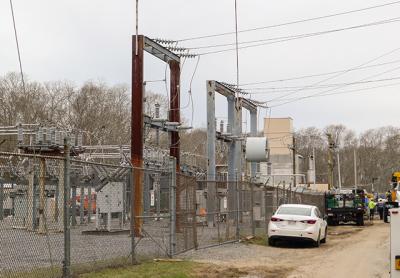National Grid Battery Plan Powers Ahead

National Grid Generation, which sells the electricity generated at its Long Island fossil fuel-based power stations to the Long Island Power Authority, plans to construct a five-megawatt battery facility on an undeveloped parcel on Cove Hollow Road in East Hampton.
The utility has filed with the New York State Public Service Commission to lease property to East Hampton Energy Storage Center, a limited liability company jointly owned with a subsidiary of NextEra Energy and formed to own and operate the battery storage facility. LIPA selected the battery facility as part of a request for proposals to address the South Fork’s energy needs.
The battery, which will help LIPA meet peak demand, will also serve as the receiving station for the South Fork Wind Farm, a 15-turbine, 90-megawatt installation that is planned for a site 30 miles off Montauk.
The battery is to be housed in a 4,000-square-foot building on a site containing a LIPA substation and National Grid Generation’s oil-burning peaker plants, which typically run during periods of high demand. The substation will connect the battery storage system to LIPA’s electricity distribution system. National Grid is also planning a battery storage facility in Montauk.
In January, LIPA inked a contract to buy electricity from Deepwater Wind, the Rhode Island company that will apply for federal and state permits to construct the offshore wind farm in waters leased from the federal government. The battery storage facility is scheduled to be operational next year, while the wind farm, if all goes according to plan, will be operational by the end of 2022.
Upon completion, the Cove Hollow Road facility will be Long Island’s first large-scale energy storage battery. Efficient storage is an essential component of renewable energy due to the variability of wind and sunlight, allowing a constant output regardless of weather conditions.
In a related development, on Monday LIPA and PSEG Long Island, which manages the island’s electricity grid on LIPA’s behalf, issued a “historic game changer,” in the words of Renewable Energy Long Island’s executive director, in the form of its draft plan for Long Island’s present and future energy needs.
Among the highlights in the document, called the 2017 Long Island Integrated Resource Plan and Repowering Studies, are LIPA’s plan to build out a renewable energy infrastructure, and a downward revision of its long-term load forecast. The utility now predicts virtually no growth in demand through 2035, a 1,700-megawatt decline from its 2013 forecast, although continued growth in demand is projected on the South Fork. Electricity production at Long Island’s fossil-fuel power plants has declined since 1999, according to the document, a trend that is expected to continue as renewable energy has become cost-competitive with new or refurbished traditional plants.
“What we’re witnessing is the beginning of the end of fossil fuels,” said Gordian Raacke of Renewable Energy Long Island, an advocacy group. “LIPA, which for more than 100 years has put all their eggs into the fossils fuels basket, is now saying, ‘We’re going to switch to renewable energy sources,’ primarily because they are now cost-effective and are going to be less costly than fossil fuels. That’s the tipping point we’ve all been pushing for, for the last few decades. It’s a big deal.”
The ascendance of renewable energy will help meet the mandate set forth in the New York State Energy Research and Development Agency’s Clean Energy Standard, which requires that 50 percent of the state’s electricity come from renewable sources by 2030.
Gov. Andrew M. Cuomo intends to go further. In his 2017 State of the State address, he set forth the long-term objective to meet 100 percent of energy needs through renewable sources. “We want to get 2.4 gigawatts of offshore wind power by 2030 and we are not going to stop until we reach 100 percent renewable,” he said, “because that’s what a sustainable New York is really all about.”
The state, Mr. Raacke said, is “taking a page from East Hampton’s playbook,” a reference to the town board’s 2014 vote to set the goal of meeting all of the town’s electricity needs with renewable sources by 2020. “That’s where this is going,” he said.
The state’s Offshore Wind Blueprint, issued in September, established a framework for development of offshore wind electricity generation. The document is a precursor to the Offshore Wind Master Plan, expected by year’s end.
